by pmdavis | Apr 1, 2016

Show military youth that you care- wear purple on April 8th!
April is the Month of The Military Child! When we think of honoring our military, we often think of Memorial Day and Veterans Day. Did you know there is also a time identified to honor our youngest heroes, military children? Since 1986, April has been designated Month of the Military Child. This allows us to honor military children and their families for their commitment and sacrifice. In Florida we have over 51,000 military youth who deal with situations like having their parents in harm’s way when they deploy. Most people think of the color green when they think of 4-H, but on April 8th, 4-H youth and volunteers in Florida will be sporting the color purple to show support for our military families.
Imagine if someone close to you were deployed. Would you like to see all the news reports showing bombs exploding and people shooting at each other? How would you feel about having long and repeated separations when your parent misses important events like birthdays, holidays, school and sporting events? Would you like it if your family had frequent relocations/moves? Every time families move, children have to make new friends, get used to new schools, and find new 4-H clubs and teams to join.
A lot of military children take these changes in stride and some even thrive on them, but it is also hard – kids have to rebuild their world every time they move. UF/IFAS Extension and 4-H are proud to be a part of the military family working with youth centers across the nation to have some consistency for youth in these situations and who are making these moves.
Here locally we want you to join us in showing your support and to celebrate our young heroes! Participate in the 6th annual Purple Up! For Military Kids. Wear purple on Friday, April 8th, as a visible way to show support and thank military children for their strength and sacrifices. Why purple? Purple is the color that symbolizes all branches of the military, as it is the combination of Army green, Coast Guard blue, Air Force blue, Marine red and Navy blue.
The goal is for our military youth to see the support of their community. Please join us in honoring these young heroes as we Purple Up! For Military Kids on April 8th! Be creative….the goal is for military youth to see the support in their school, youth groups, and the community! If you don’t have or own a purple shirt wear a purple ribbon, tie, headband etc. Just show your support and let our youth know we care about them! Can’t make the 8th then do something another day in April. We would like to encourage you to take pictures of your group wearing purple and share them on social media. If you are willing to share then e-mail them to us.:bay@ifas.ufl.edu or post photos to Facebook and tag us https://www.facebook.com/bayifas/ or comment and add your photo.
by Stefanie Prevatt | Mar 25, 2016

4-H has helped this Washington County youth develop confidence to speak in front of groups. Photo credit: Julie Dillard, UF IFAS
A 2001 Gallup poll found that 40% of Americans suffer from glossophobia, or fear of public speaking. This statistic inspired the famous joke by stand-up comedian Jerry Seinfeld that at most funerals, “the average person would prefer to be the one in the casket rather than the one delivering the eulogy.” Fortunately, 4-H offers an easy antidote through our public speaking program. 4-H public speaking helps youth:
- Demonstrate mastery of a subject
- Practice quality communication
- Increase self-confidence when speaking in front of others.
How and where would you find a 4-H volunteer teaching public speaking? Almost anywhere you’ll find 4-H activities! Here are some examples:
The main public speaking education program supported by your 4-H Office is called County Events.
What is County Events?
County Events is a venue in which 4-H’ers can share what they have learned in their project work though several different contests, including demonstrations and illustrated talks. These are show-and-tell type presentations lasting 3-12 minutes in which a 4-H member shows mastery of a subject matter area. Some contest regulations include:
- Talks must fall between 3-12 minutes for juniors and intermediates, and 5-12 minutes for seniors.
- Team demonstrations must show active, equal participation of both members.
- Presentation must fall under an approved category.
Creating a Presentation
- Topic Selection- should be age appropriate and preferably related to their 4-H project.
- Organizing Thoughts- points should be logical and support the main theme.
- Visuals- neat, attractive and easy to read
- Practice Strategies- club meetings are a great place to practice and practice makes perfect!
Creating Buy in
Last month our Make a Difference Monday online volunteer training addressed ways for club leaders and parents to get their youth excited about public speaking. Regional Specialized 4-H Agent Stacey Ellison shared some creative ideas to encourage youth and families to “buy in” to the idea of public speaking:
- Set expectations
- Have older youth mentor younger youth
- Use the team approach
- Approach it as a game show or cooking show where they can highlight their knowledge or skills
Awards and Recognition
County Events combine two forms of achievement and recognition for youth. These are:
- Peer Competition (a panel of judges subjectively identifies, in a concrete time and place, the best teams or individuals through ranking)
Through this dual recognition system it would be possible for a blue ribbon presentation to place third in peer competition. All 4-H’ers who achieve blue ribbon standard at the county level move forward to the district level of competition.
If you have a passion for public speaking, consider becoming a 4-H volunteer. We are in need of judges for our speech contests as well as speech coaches. For more information on County Events please contact your local UF IFAS County Extension Office or visit http://florida4h.org.
by Melanie Taylor | Mar 24, 2016

Use St. Patrick’s Day to learn about Irish culture in your 4-H club
I just discovered a few years ago that my great-grandmother, whom I never met, was an Irish redhead. I found this very exciting. It made me much more interested in learning about the history of St. Patrick’s Day, beyond wearing green. We live in a culture where we look for the next person or event to celebrate. For those who are Irish, St. Patrick’s Day is a time to reflect and celebrate their culture and traditions. So, although you may not be Irish, why not learn more about the Irish culture and why they are proud of their heritage? At your March 4-H club meetings, it would be fun to celebrate St. Patrick’s Day and incorporate the four-leaf clover and relate it back to the 4-H clover and what they both represent. Whether you are a 4-H leader or a teacher or parent looking for creative ideas, I hope you enjoy this brief history lesson and a few suggestions.
Let’s start from the beginning…
Who was St. Patrick? St. Patrick is the beloved patron saint of Ireland. The Irish are famous for spinning exaggerated tales. Despite the infamous stories traditionally attributed to St Patrick, this is what we actually known about his life. We do know that St. Patrick was born in Britain and that at the age of 16 was captured by Irish raiders who attacked his family’s estate. He was then transported to Ireland where he was held captive for six years, living a solitary, lonely life as a shepherd. It was then that he became a devout Christian, embracing his religion for solace. From his writing, we know that a voice, which he believed to be that of God, spoke to him in a dream, urging him to leave Ireland. He did. Walking nearly 200 miles, St. Patrick escaped to Britain and undertook serious religious training.
After 15 years of study, Patrick was ordained as a priest and sent to Ireland. His mission was to minister to Christians and to convert the Irish, then pre-dominantly pagans, to Christianity. Because St. Patrick was familiar with the Irish language and culture from his years of captivity, he chose to incorporate Irish ritual and symbols into his teachings rather than to eradicate Irish beliefs.
Why Do We Celebrate St. Patrick’s Day in America? The history of St. Patrick’s Day in America begins with Irish soldiers serving in the British army. The celebration’s focus is based on a tale of the Irish and evolving political power. The very first parade in New York City in 1762, not only helped the homesick Irish soldiers connect with their roots through the familiar strains of traditional Irish music, usually featuring bagpipes and drums, but also helped them to connect with one another, finding strength in numbers. Over the years as nearly a million Irish immigrants fled to America in the wake of the Great Potato Famine, St. Patrick’s Day parades became a display of solidarity and political strength as the often ridiculed Irish immigrants were frequently victims of prejudice. Soon enough, however, their numbers would be recognized and the Irish would organize and exert their political muscle, becoming known as the “green machine.”
Today, although less religious, St. Patrick’s Day celebrations continue to be a show of Irish strength and patriotism. So, put on your GREEN and get ready to celebrate!
4-H Club Meeting, Classroom, and Family Theme Ideas for March:
1) During a meeting or event read a “thought for the day” and use an Irish quote.
Example: May your blessings outnumber
The shamrocks that grow,
And may trouble avoid you
Wherever you go.
-An Irish Toast
2) Encourage the youth to wear green.
3) Provide or encourage youth to bring themed snacks to share, such as,
- Sliced fruit designed in shape of a rainbow, with vanilla wafers as the pot of gold, and yogurt fruit dip
- Rice Krispy treats colored with green food coloring and cut into four-leaf clover
- Green colored pudding or popsicles.
- Green fruit and vegetable trays (cucumbers, peppers, apples, grapes, kiwi).
4) “Make and Take” crafts, such as,
- Handprint four-leaf clovers with green paint on white paper
- Origami and/or construction paper four-leaf clovers.
5) Share these Fast Facts about Four-Leaf Clovers:
- There are approximately 10,000 three-leaf clovers for every “lucky” four-leaf clover.
- There are no clover plants that naturally produce four leaves, which is why four-leaf clovers are so rare.
- Today, four-leaf clovers are associated with St. Patrick’s Day, but they appear in centuries-old legends as symbols of good luck. The Druids (ancient Celtic priests) said they could see evil spirits coming and have a chance to escape in time. Four-leaf clovers were Celtic charms, presumed to offer magical protection and ward off bad luck. Children in the Middle Ages believed if they carried a four-leaf clover, they would be able to see fairies. The first literary reference to suggest their good fortune was made in 1620 by Sir John Melton.
- The leaves of four-leaf clovers are said to stand for faith, hope, love, and luck.
- It’s often said that Ireland is home to more four-leaf clovers than any other place, giving meaning to the phrase, “the luck of the Irish.”
If you have a passion for cultural heritage, consider becoming a 4-H volunteer. We need volunteers willing to share their rich cultural heritage with the next generation so that they can grow into a culturally competent workforce of tomorrow. For more information, contact your local UF/IFAS Extension Office or visit http://florida4h.org/volunteers.
by amgranger | Mar 18, 2016
“When I was growing up 50 some years ago in West Gadsden County, I had no idea that the people that were a part of my everyday life would someday chart my path for the future.”
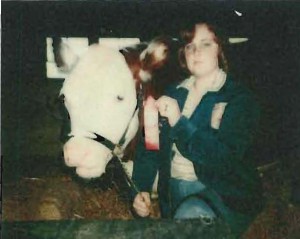
Angel (Clark) Granger showing her steer in Gadsden County, igniting a lifelong passion for 4-H.
I didn’t realize until recently just how deeply my roots are tied to 4-H. Not only does my family represent four generations of 4-H (with the addition of my granddaughter joining this year), but because there were people I took for granted that were absolutely engrained in Extension and 4-H.
I was the first child of Nelson and Karen Clark. I grew up on a farm raising cattle and goats. My grandmother was Ruby Scott Clark and everybody called me “Little Ruby” when I was growing up. She taught me how to string tobacco, garden, ride horses, drive a car, and how to make hoecake. My Granny’s best friend was Miss Elise Lafitte, County Home Demonstration Agent in Gadsden County during the 1950’s. She introduced my aunt, Shirley Clark, a now retired FCS Agent, to my uncle, Scott Clark. My cousin Bernard Clark was an Extension Agent in Gadsden County who is in the Florida 4-H Hall of Fame. My uncle Charles Rowan was an Ag Agent in Dixie and Pinellas Counties. If you read the chapter regarding Gadsden County in the book commemorating the 100 year Anniversary of 4-H in Florida, “Florida 4-H, A century of Youth Success”, you will see my Dad, my sons and me highlighted for our three generations of 4-H participation.
Growing up, I never tried to figure out what Extension was or why we had 4-H, it was just always there. My 4-H Agent growing up was Dickie Bentley. She made monthly visits to Greensboro Elementary School to teach us about record books and 4-H projects. I learned about veterinary science, public speaking, and how to give a demonstration. I still have every ribbon and pin I earned.
I left high school in the eleventh grade to help save the family farm from foreclosure. I soon married my husband Anthony and we moved to Tallahassee to work. In 1985 we bought 10 acres from my Dad, and we moved back home. In 1988 my second child, Cody was born. From the time they were old enough to tote a bucket, my husband and I worked the farm with my dad and taught our sons the value of life on the farm and family traditions.
I have a 4-H Exhibitor Card that was my Dad’s for ears of corn he entered as a 4-H Exhibit, as well as pictures of him showing cattle as a
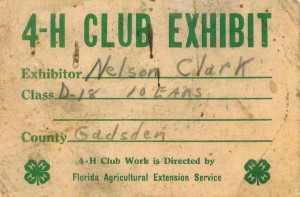
Angel still has her father’s 4-H exhibit card for corn he grew and exhibited at the fair. circa 1956
4-Her. He made sure that I had those same opportunities in 4-H. He bought steers, hogs and feed for me to show as a child, and later also for my oldest son Cole. He and proudly watched Cole work with and show his first steer in 1994.
Sadly, I lost my Dad three months later. He was only 54 and had spent his whole life trying to keep our farm going. I watched my Dad struggle every day, working as a barber, a school bus driver, and a farmer to make ends meet. He bought cheap cattle, made poor decisions regarding crops, nearly lost everything to bankruptcy and soybean disaster, but he never gave up. I vowed the day I buried my Dad that I was going to find a way to help other people like my Dad, I just never dreamed it would lead me into Extension.

Angel’s sons, Cole and Cody Granger, also grew up in the 4-H family tradition and reply on many of the skills they learned in 4-H in their jobs as civil engineers.
After dad’s death, we continued what he started by keeping the boys in 4-H. I became the livestock club leader. My husband also volunteered to keep our boys active in 4-H showing cattle, hogs, and horses, and competing in county events until they both graduated high school. Both of my sons will tell you that 4-H played a huge role in making them the men they are today. They were part of clubs that had inclusive environments, they had opportunities to meet new people and were both able to use the skills they mastered to be successful in not only their college careers, but as professional engineers today.
After my sons finished high school and started college, I decided it was time to finish my education as well. Both of my sons graduated with degrees in Civil Engineering and I graduated with a degree in Agriculture with Emphasis in Animal Science. I had dreams of
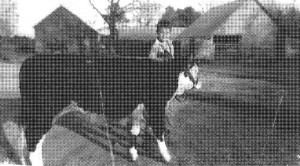
Nelson Clark showing a steer, circa late 1940’s/early 1950s
becoming an Extension Agent and working with farmers and families to help them make good decisions and have access to resources. After two years, I was hired as the 4-H Youth Development Agent in Jackson County (ironically my Granny was born and raised in Bascom, a small town in Jackson County). After a successful 32-year career with the Florida Department of State, I set out on another exciting 4-H journey. Every day I strive to honor the memory of my Dad (who would have been 76 years old this month), my Granny, and my other family members who have been part of the legacy of Extension. Most importantly, I strive to make a difference in a young person’s life just like my 4-H Agent did.
Are you part of a 4-H family tradition? If not, consider starting one today. 4-H offers a broad spectrum of projects and activities to serve a variety of interests, skills, and knowledge. Contact your local UF IFAS Extension office or visit http://florida4h.org to enroll as a youth member or adult volunteer!
by Julie Pigott Dillard | Mar 4, 2016
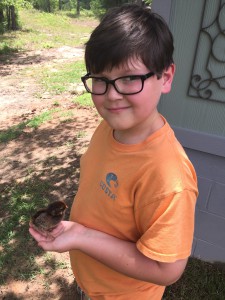
Chick Chain is a great way for youth to learn life skills such as responsibility and record keeping while developing an appreciation for agriculture.
Can you feel it? The promise of spring is in the air. Pollen is falling, grass is greening up, azaleas are blooming and it’s time to kick off the 2016 Florida 4-H Chick Chain project. This program is designed to help youth learn how to raise baby chicks to laying age while learning responsibility, record keeping and communication skills. How does the 4-H Chick Chain work? Youth will select two breeds of chickens to raise and take ownership of 12 baby chicks. Breeds include:
- Pearl White Leghorn
- Rhode Island Red
- Dominque
- Golden Laced Wyandotte
- Polish Top Hat
- Buff Brahma
Youth will raise the chicks to about 22 weeks old and then participate in a district show and showmanship contest with their three best pullets (young hens less than one-year-old) from one breed. If there is more than one child in your family, you can choose to share one project.
The 4-H Chick Chain is designed to take you step by step through the process of raising your birds to healthy laying age. Before you take ownership of your chicks, you’ll participate in a youth/parent workshop where you’ll receive a production manual and tips to make your project a success. During the summer, there will be a care and showmanship workshop in your 4-H district. Your 4-H Agent or volunteer will also make a home visit to check up on your progress. We’ll also have a record book workshop to help you tackle the record keeping part of your project.
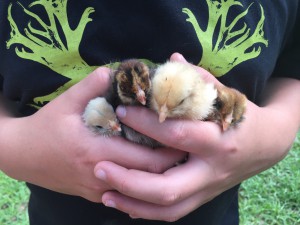
Youth will learn about animal nutrition, health and biosecurity as part of the 4-H Chick Chain.
The 4-H Chick Chain is open to all youth ages 5-18. Registration cost is $50 and includes your 12 chicks, production manual and entry for the show and showmanship contest.
How do I sign up? To register for the 4-H Chick Chain, click here: 2016 Chick Chain Registration Form. Follow the instructions on the registration form, and contact your 4-H Agent if you have questions. Youth who participated in the 2015 4-H Chick Chain can register their hens to show in a production class.
If you have a love of poultry that you would like to share with others, consider becoming a 4-H poultry project leader. Volunteer positions are currently available to support 4-H Embryology in the Classroom, Chick Chain, and 4-H Poultry Clubs. Contact your local UF IFAS Extension Office or visit http://florida4h.org/volunteers to find out more.
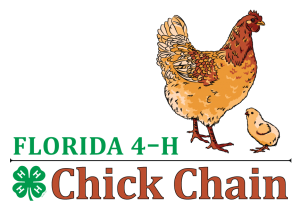
by ewestbrook | Feb 26, 2016
 It’s February in Florida and as the weather gets warmer we Floridians start to turn our attention to the thousands of outdoor activities our beautiful state has to offer. Florida is not just known for its natural beauty, it is also known for it abundance of mosquitoes. With the mosquito transmitted Zika virus making headline news and the tell tale itchy red bites popping up on our unprotected skin you may be wondering what you can do to protect your family in the coming months. Millions of dollars are spent in Florida every year to combat mosquitoes. Municipalities will often spray for mosquitoes and use larvacides in wetland areas to control the pests. You can make a big difference in the effort to combat the blood-sucking parasites and prevent disease transmission by following the five d’s of mosquito control and prevention.
It’s February in Florida and as the weather gets warmer we Floridians start to turn our attention to the thousands of outdoor activities our beautiful state has to offer. Florida is not just known for its natural beauty, it is also known for it abundance of mosquitoes. With the mosquito transmitted Zika virus making headline news and the tell tale itchy red bites popping up on our unprotected skin you may be wondering what you can do to protect your family in the coming months. Millions of dollars are spent in Florida every year to combat mosquitoes. Municipalities will often spray for mosquitoes and use larvacides in wetland areas to control the pests. You can make a big difference in the effort to combat the blood-sucking parasites and prevent disease transmission by following the five d’s of mosquito control and prevention.
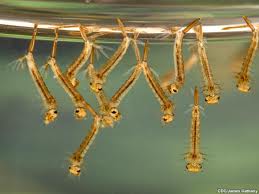
Larval mosquitoes in a pool of water
- Dump- Mosquitos spend the beginning of their lives developing in aquatic environments and they don’t mind small spaces. By periodically dumping standing water you can prevent them from growing into adults that feed on you. Standing water in old tires, plant containers, buckets and any other containers with standing water all provide a great environment for many species of mosquitoes to develop. By being vigilant in dumping these containers you are doing a lot to control mosquito populations.
- Drain– Kiddy pools, water troughs, pet water dishes and birdbaths all provide an ideal environment for mosquito larva to grow. You can prevent this by regularly draining and refilling these water sources.
- Dress– When you are dressing to go outdoors in the warmer months in Florida prepare for mosquitoes. Wear clothing that covers as much skin as possible to prevent bites. Long pants and long sleeve shirts made out of lighter materials like linen are ideal in our hot summer climate when venturing into the great outdoors. Also consider hats with mosquito netting
- DEET- Use an insect repellent that lists DEET or alternatively eucalyptus oil to prevent mosquito bites. DEET is proven to be the most effective repellent and safe for human use. Bug zappers, candles and ultra- sonic devices are not effective mosquito control measures. Save your money and invest in proven solutions like DEET based insect repellents.
- Dusk/Dawn- Mosquitoes are most active during the early morning and evening hours. Try to stay indoors during these time periods and if that is not possible make sure you are dressed to prevent mosquito bites and using DEET based insect repellent.
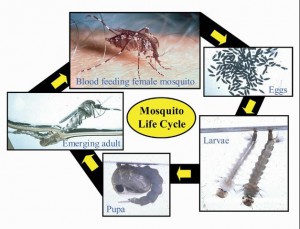
The mosquito lifecycle
For more information on mosquitoes in Florida call you county UF|IFAS Extension Office or county health department and check out these in-depth articles on the subject:
http://mosquito.ifas.ufl.edu/Fact_Sheets.htm
https://edis.ifas.ufl.edu/in851
http://edis.ifas.ufl.edu/in652
Do you have a love for the outdoors? Would you like to share your passion for the environment with the next generation of Florida citizens? If so, consider becoming a 4-H volunteer. Florida 4-H offers a range of opportunities for volunteers to teach youth about natural resources, shooting sports, and water conservation (just to name a few). For more information about becoming a 4-H volunteer, visit your local UF IFAS County Extension office or http://florida4h.org/volunteers.
by Jenny Savely | Feb 19, 2016

By 2050, the United Nations estimates that the total population will total around 9 billion people globally (United Nations: 2004). Meeting the challenge of addressing the needs of so many people is an opportunity for growth that can be gained through scientific developments and personal responsibility, areas in which 4-H eagerly works to educate youth and adults.
We learn that our everyday behaviors, even if they seem very small, can actually put a lot of strain on our environment when so many people do the same things.
We often ask our youth, “If everyone were to do the same things you do every day, what would that look like? What kind of impact do you think it would have?”.
We know that much of our daily energy use, like the amount of water we use, how much trash we produce, the kind of food we buy and where we buy it, and how much energy we use in our transportation, for example, can make a big difference if we all make decisions that keep our environment in mind.
We can help prevent environmental damage that leads to climate change and human illness by conserving energy and making a smaller ecological footprint. An ecological footprint is the amount of resources from the environment that are required to meet the demands of our everyday consumption of goods. 4-H encourages youth to make thoughtful decisions about their behaviors such as:
- Eating locally grown and in season produce
- Using reusable bags for shopping
- Buying products with less packaging and that are less processed
- Turning lights off when they aren’t in use
- Doing outdoor rather than indoor activities
- Walking, biking, carpooling, or taking public transportation
- Recycling
- Conserving water when brushing teeth and by displacing water in toilet tanks
- Only running washing machines with full loads
However, motivating people to change their behaviors can be difficult. In 4-H we work to encourage young people to understand at an early age the enormous impact they have on the health and well-being of others. The World Health Organization tells us that “…environmental factors are a root cause of a significant burden of death, disease and disability – particularly in developing (poor) countries. The resulting impacts are estimated to cause about 25% of death and disease globally, reaching nearly 35% in regions such as sub-Saharan Africa.” (World Health Organization: 2016). A good portion of environmental damage that affects us in negative ways is caused by our using more resources than our planet has the ability to renew at the same rate we use them and by extracting our resources in harmful ways. This may seem overwhelming, but there are actually very simple things that each of us can do that can significantly help lessen the impact. Actually, when we change our behavior is western countries like the United States, we can make more significant differences since we are one of the primary consumers of energy in the world.
And as always, youth learn not only by DOING but by helping to teach others! We encourage our youth to educate their friends and family as well as to mentor younger 4-H’ers in project areas like environmental science. If your youth or club is interested in learning more about energy conservation and environmental science projects, there are an array of wonderful resources, listed below, to help get you started. Your county 4-H agent is happy to help any youth or volunteer interested in this or any one of the project areas that help provide youth with research based education.
Games: http://www.energystar.gov/index.cfm?c=kids.kids_index
Curriculum: http://www.chesapeakebay.net/channel_files/18256/handout_-_4-h_environmental_curriculum.pdf
http://www.need.org/files/curriculum/guides/Saving%20Energy%20Student%20Guide.pdf
Resources for teachers: http://www.eia.gov/kids/energy.cfm?page=6
http://www.eia.gov/kids/energy.cfm?page=1
http://coseenow.net/antarctica/
United Nations. 2004. “World Population to 2300”. United Nations Department of Economic and Social Affairs: Population Division. United Nations: New York, NY.
World Health Organization: The Health and Environment Linkages Initiative (HELI). 2016. “Environment and Health in Developing Countries”. URL http://www.who.int/heli/risks/ehindevcoun/en/index1.html. Accessed February 5, 2016.
Photo: Wake County, North Carolina 4-H. http://www.wakegov.com/humanservices/family/4h/traditional/Pages/default.aspx
by Monica Brinkley | Feb 12, 2016
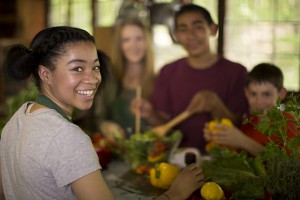
Making family meal time a priority can increase your children’s self esteem.
In a recent book entitled The Surprising Power of Family Meals, author Miriam Weinstein asks this question:
“What if I told you that there was a magic bullet-something that would improve the quality of your daily life, your children’s chances of success in the world, (and) your family’s health…? Something that is inexpensive, simple to produce, and within the reach of pretty much everyone? (Weinstein, 2005, p. 1)”
You guessed it, that magic bullet is the family meal! According to research, eating together as a family on a regular basis has some surprising effects. When sharing a meal together family bonds become stronger, children are better adjusted, family members eat more nutritional meals, they are less likely to be overweight, and they are less likely to abuse alcohol or other drugs. Given the positive benefits of eating together, why are more families not doing it?
It may come as a surprise to you that 71% of older children and teenagers consider talking/catching-up, and spending time with family members as the best part of family dinners. Family meals are a representation of the ethnic, cultural, or religious heritage of the family (Weinstein, 2005). A study found that children who knew a lot about their family history had a closer relationship to family members, higher self-esteem, and a great sense of control over their own lives (Duke, Fivush, Lazarus, & Bohanek, 2003).
With this in mind, why not make shared family meals a priority. Emphasize the importance of being together, not creating an elaborate meal that everyone will enjoy. Set regular meal times by writing them on the calendar. Let everyone know when dinner is served and when they must be home.
If the family is not used to eating together regularly, start small. At first, get used to eating together by scheduling family meals two or three days per week. Then, as the weeks progress, begin to have more and more regular meals.
Make family meals fun. Include children in the preparation of the meal and in the decision about what foods will be offered during the meal. Of course, parents have final say about what foods are prepared, but allowing the children to participate can create a fun environment.
- Keep a sense of humor while at the dinner table.
- Eliminate distractions, like TV, telephone, and cell phones.
- Limit conversations to positive or neutral topics.
- Be a good role model. Show children good etiquette and table manners.
Eating together as a family is more than just a meal, it is an opportunity for families to come together regularly in support of family unity. Although there is no guarantee that eating together as a family will resolve all family problems, it may provide the opportunity to make a fresh start. Do you have a passion for meal preparation or etiquette that you would like to share with the next generation? Consider becoming a 4-H Volunteer! Visit our website or contact your local UF IFAS Extension Office.
For the more information on this topics please visit the EDIA website at http://edis.ifas.ufl.edu, FCS8871.
Source Family Nutrition: The Truth about Family Meals, Larry Forthun
by pmdavis | Feb 5, 2016
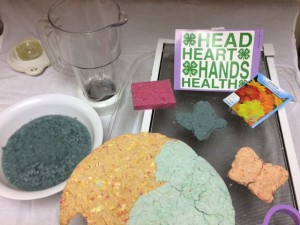
Grow Card Supplies and products
4-H literally got its start with gardening. The very first 4-H Clubs focused on growing tomatoes and corn for boys and canning for girls. Many youth and volunteers still enjoy gardening projects today. One great curricula that is used is the Junior Master Gardening Program. This program allows youth to enhance their life using gardening as the spark of interest. Gardening enriches youth’s lives, promotes good health, gives a sense of environmental awareness and saves money.
One of the activities I enjoy doing with youth combines gardening with recycling and crafting. As a group we will make our own paper grow cards or ornaments that have seeds embedded in them. Once the cards are dry, we deliver them as a service project. The cards are fun and inexpensive to make and are a perfect activity for your next club meeting! Try making them as valentines for Valentines Day. For beginners, we recommend growing tomatoes, lettuce, peppers, cucumbers, basil, chives, or parsley. Not into vegies? Try starting marigolds, cosmos, sunflowers, zinnias, pansies, or petunias.
Download our detailed factsheet with photos and directions. This activity is great for any occasion when you need a card or small gift. You can use as party favors by making them into ornaments using raffia to hang them from a tree or gift bag. You can take them to a nursing home, veterans center, hospital or other site as a service project for your club. Just be sure to share with the individual that they need to plant your card or ornament. It is a great way to help youth share their joy of gardening with others.
Other Extension gardening resources include:
• Florida Vegetable Gardening Guide
If you have a green thumb, consider going “totally green” as a 4-H gardening volunteer! 4-H needs caring adults like you to share their knowledge and passion for gardening with the next generation. Through the 4-H gardening project, youth not only learn gardening knowledge and skills, they also learn responsibility, teamwork, and other life skills that will help them grow up to be compassionate and competent citizens. To get involved, contact your local UF IFAS Extension Office, or visit Florida 4-H.
by Jena Gilmore | Jan 29, 2016
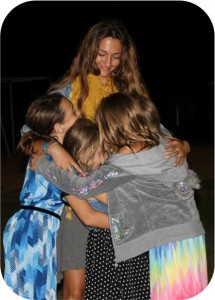
Teen retreat participants can earn credits towards their camp counselor certification.
Each summer Florida 4-H camps are bustling with 4-H volunteers, staff, and youth enjoying their week long residential camping experience. As a significant delivery mode in experiential learning, residential camping annually is home to nearly 4000 youth participants and 250 volunteers and agents. Within this mixture are some very important teens that give up their week as a “camper” and graduate to the role of “Counselors” or “Counselors-in-Training (CIT).” These teens, ages 13-18 sacrifice alone time, electronics, and sometimes their sanity in order to fulfill their leadership role at camp and place their campers needs ahead of their own. We’ve seen them overcome struggles, we’ve seen their growth, and we want to pay them back for all the countless hours they have dedicated to the program!
Therefore, the 2016 4-H Teen Retreat is scheduled for February 19th-21st at Camp Cherry Lake for ages 13 to 18! This is no ordinary camping experience for Counselor and CIT age teens. There will be no responsibility of campers but definitely the responsibility of having fun while teambuilding with other teens across the Northwest District. In doing so, teens will participate in workshops, fun-shops, listen to a key note speaker to inspire the leader within them, and then finish up the weekend with dancing, fun activities, and more. All camp rules and dress codes apply for the weekend. This fun-packed weekend costs $90 (scholarships may be available) and you can send payment and registration forms to your local 4-H Agent at the county Extension Office. This program would not be possible without the generous support of Farm Credit of Northwest Florida. Teen Retreat is just one of the ways that Farm Credit is helping 4-H grow future leaders. 
Furthermore, within the 4-H Teen Retreat mini camping experience, teens will have the opportunity to discover the spark within themselves, ignite that spark, and see personal growth with the guidance of 4-H through activities that foster Leadership, Confidence, Compassion, Curiosity, and Creativity. Teens will gain leadership skills and confidence in their abilities as leaders and productive members of their community through workshops focusing on teamwork and personal goal setting. Next, teens will experience growth in compassion as they work together to complete a service project by contributing to “Sole Hope,” an organization that helps place closed toed shoes on the feet of children in third world countries. Lastly, teens will express and grow their curiosity and creativity in “fun-shops” offering projects in photography, videography, nine-square, and para cord bracelet making.
Teens that participate in the 4-H Teen Retreat will leave camp with an arsenal of leadership skills, problem solving strategies, community service ideas and much more to take back to their counties. Teens may also expand their leadership potential by participating in some of UF/IFAS 4-H Priority Programs such as community clubs by becoming an officer or enhancing their current position; participation in citizenship and leadership through 4-H Legislature (June 27-July 1) participation in county events and attending 4-H University (July 25-29th.) Below are links to the State Events page where youth can customize their 4-H experience and tailor participation in events to fit their own personal leadership goals.
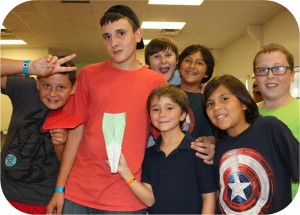 By participating in 4-H, youth are reported over twice as likely not to participate in risky behavior and are over 3 times more likely to contribute to their communities as compared to non-4Her’s (Florida 4-H: Facts & Impacts.) In the 2014 4-H Common Measures Statewide Survey of 4-H Seniors, 92% reported they know how to deal with stress in positive ways, 84% agree they learned things that helped them make a difference in their communities, 98% agreed they respect people from other cultures, and 95% agreed they can apply knowledge in ways that solve real-life problems through community service. These statistics show that through participating in 4-H activities and events, youth are becoming more competent, productive citizens in their communities. This in turn leads 4-H youth to be better prepared for leadership roles within the workplace.
By participating in 4-H, youth are reported over twice as likely not to participate in risky behavior and are over 3 times more likely to contribute to their communities as compared to non-4Her’s (Florida 4-H: Facts & Impacts.) In the 2014 4-H Common Measures Statewide Survey of 4-H Seniors, 92% reported they know how to deal with stress in positive ways, 84% agree they learned things that helped them make a difference in their communities, 98% agreed they respect people from other cultures, and 95% agreed they can apply knowledge in ways that solve real-life problems through community service. These statistics show that through participating in 4-H activities and events, youth are becoming more competent, productive citizens in their communities. This in turn leads 4-H youth to be better prepared for leadership roles within the workplace.
Take advantage of everything 4-H has to offer by kick-starting 2016 with the 4-H Teen Retreat! For more information on how to sign up for the 2016 4-H Teen Retreat contact your local 4-H Agent and complete the registration form below. For resources on leadership please visit these EDIS publications referenced in this article.
- Teen Retreat Registration & Medication Forms:
http://walton.ifas.ufl.edu/wp-content/uploads/2016/01/Teen-Retreat-Registration_Fillable.pdf
http://walton.ifas.ufl.edu/wp-content/uploads/2016/01/Medication_Form.pdf
- Florida 4-H Camping Facts & Impacts:
http://florida4h.org/camps/files/4-H_Facts_and_Impacts-Camps.pdf
- Florida 4-H Facts & Impacts:
http://florida4h.org/about1/impact/4-H_Facts_and_Impacts.pdf
- 4-H Common Measures Statewide Survey:
http://florida4h.org/about1/impact/4-H_Statewide_Survey_of_Seniors.pdf



















